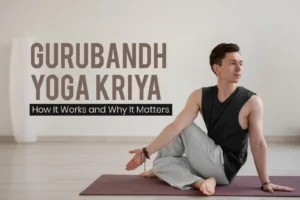Table of Contents
ToggleHatha Yoga is a branch of Yoga that focuses on physical postures (asanas) and breath control (pranayama) to promote overall health. The term “Hatha” represents the balance of opposing forces, such as strength and flexibility. Through the practice of various asanas, Hatha Yoga aims to stretch, strengthen, and align the body, improving physical fitness. It also involves breath control techniques to regulate the flow of life force energy (prana) within the body, fostering vitality and mental clarity.
Hatha Yoga combines physical postures with mindfulness and meditation, encouraging practitioners to be present at the moment. Regular practice of Hatha Yoga is believed to improve physical strength, flexibility, and balance while reducing stress and fostering a sense of harmony.
Aim Of Hatha yoga
Hatha Yoga, also known as the science of purification, aims to cleanse both the body and the nadis (energy channels). According to the principles of Hatha Yoga, achieving purification of the mind necessitates the essential process of absolute purification for the entire body.
This ancient practice focuses on purifying and balancing the physical body through various asanas (postures) and breath control techniques. By engaging in Hatha Yoga, practitioners seek to eliminate toxins, tension, and imbalances in the body, thereby creating a foundation for mental clarity and spiritual growth.
The emphasis on purification in Hatha Yoga highlights the interconnectedness of the body and mind, recognizing that a purified body supports the attainment of a purified mind and higher states of consciousness.
How is Hatha yoga different from regular yoga?
Hatha yoga is a branch of yoga that focuses on physical postures (asanas) and breath control (pranayama) to achieve a balance between mind and body. It is one of the most popular and widely practised forms of yoga.
Regular yoga is a broad term that encompasses various styles and approaches to yoga. It can include Hatha yoga, as well as other forms such as Vinyasa, Ashtanga, Bikram, Kundalini, and more. Each style of yoga has its unique emphasis and characteristics.
Here are a few ways in which Hatha yoga is often distinguished from other forms of yoga:
- Gentle Pace – Hatha yoga typically involves a slower pace compared to more dynamic styles like Vinyasa or Ashtanga. It focuses on holding asanas for a longer duration, allowing practitioners to explore and deepen their postures.
- Focus on Alignment – Hatha yoga places a strong emphasis on proper alignment in each pose. Practitioners are encouraged to pay attention to their body’s alignment, making adjustments as needed to ensure the safety and effectiveness of the pose.
- Breath Awareness – Hatha yoga emphasizes the coordination of breath with movement. Specific breathing techniques, known as pranayama, are incorporated into the practice to enhance breath awareness and control.
- Mind-Body Connection – Hatha yoga aims to cultivate a deeper awareness of the mind-body connection. It encourages practitioners to be present at the moment, focusing on the sensations, thoughts, and emotions that arise during the practice.
- Holistic Approach – Hatha yoga seeks to balance and harmonize all individual aspects, including physical, mental, and spiritual well-being. It provides a comprehensive approach to yoga practice, incorporating asanas and pranayama, meditation and relaxation techniques.
Hatha yoga focuses on physical postures and breath control for mind-body balance. It highlights alignment, gentle pace, breath awareness, and holistic well-being. It is a branch of yoga that is usually practised slower than other dynamic styles.
Benefits Of Hatha Yoga
Hatha yoga offers numerous benefits for physical, mental, and emotional well-being. Benefits of practising Hatha yoga include:
- High Physical strength, flexibility, and balance.
- Reduction of stress, and anxiety, and improved relaxation.
- Enhanced mental clarity, focus, and cognitive function.
- Promotion of emotional well-being, self-acceptance, and confidence.
- Better posture and alignment, decreasing the risk of injuries.
- Boosted energy levels and vitality.
- Improved sleep quality and patterns.
- Boosted immune system and overall physical health.
- Promotion of a sense of inner peace and harmony.

Hatha Yoga is a powerful practice that blends physical postures (asanas) with breath control (pranayama) to cultivate a balance between the body and mind. It offers numerous benefits, including increased flexibility, strength, and relaxation. Regularly practising Hatha Yoga, individuals can improve their overall health and achieve a sense of inner balance and peace.
For those interested in exploring more about yoga and its various aspects, I would highly recommend visiting the Hidden Mantra website’s blog session. There, you can find a wealth of yoga-related content, such as articles on different yoga styles, meditation techniques, mindfulness practices, and tips for maintaining a healthy lifestyle. The blog provides a valuable resource for deepening your understanding of yoga and including its teachings in your daily life.
👉 Read: Classical Yoga
👉 Read: Preclassical yoga
Yoga For Complete Beginners
Visit Our Hidden Mantra Instagram to stay connected and improve your learning and practice of yoga.




















One Response
Hatha yoga emphasizes the connection between the body, breath, and mind. Through the practice of yoga postures and breathing techniques, practitioners can cultivate a greater sense of awareness and mindfulness.